How to Grow Squash & Enjoy a Big Succulent Harvest
Author: Jen Worst | Editor: Omar Alonso
Review & Research: Jen Worst & Chris Miller

Learning how to grow squash is as simple as reading these words. The only challenge is having patience and taking care of your plants as they thrive before you get to enjoy a sizable harvest.
This is one of the most commonly grown vegetables across the nation due to the simplicity in the process and the delicious meals that come after. If you can water a plant, then you can handle having this veggie in your garden.
How to Grow Squash
Squash is among the oldest domesticated crops we know about. Squash cultivation began as far as 10,000 years ago, if not more, according to evidence found in sites in Mexico.
This is an immensley popular choice for backyard vegetable gardens as it's easy to grow in many different regions of the United States. Literally anyone can do it, so let's waste no more time and jump right into it.
Choose a Squash Type Based on Taste & Harvest Time
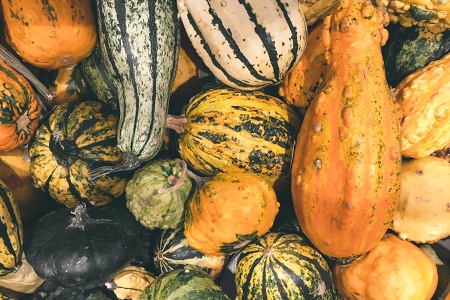
There are a lot of squash varieties you can choose from when you decide to start a vegetable garden. The different types of squash can be sorted into two broad categories—summer and winter.
Don’t let these names fool you though. Both are warm-weather plants that need to be planted once the frosty season has passed and the soil has warmed up.
Summer squashes are soft-skinned varieties that can be harvested during the early summer months. They come in as large and bushy plants before the vegetable appears on the runners.
Zucchini, tromboncino, scallop, straight neck, crooked neck are some common summer squash varieties.
Winter squashes are hard-skinned varieties that aren't ready to be harvested until the end of summer. They can be stored for long periods, and often last until winter months if stored properly. Hence the name!
Most winter squashes are vine plants that will spread out over large areas. Some common winter varieties you can choose from are acorn, butternut, spaghetti, and hubbard.
You can treat them as climbing vegetables though their weight may become an issue. It's better to let them run along the ground.
How to Plant Squash - From Seed or Transplant
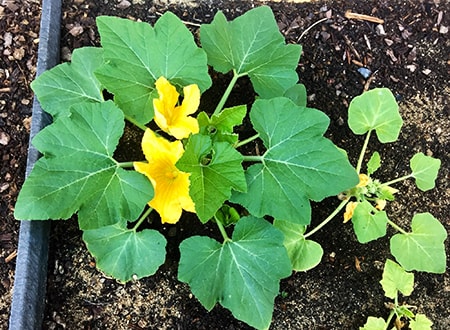
You can start a squash patch either from seeds or using starter plants. If you have a long and warm growing season, seeds are the most economical option.
However, if the warm weather in your region has a short lifespan you can buy starter plants from your local nursery or farmer’s market. They'll mature faster and help you dodge that final frost.
The seeds can be sown directly into the garden or started indoors 3 to 4 weeks before you plan on planting them outside. You can start the seeds in peat pots. Starting indoors can get you to your harvest a bit sooner.
Begin moving the plants outdoors when the weather is right while keeping them in their pots. Start with just a couple hours per day and add more time every day over the course of a week or so.
You can then plant the hardened plants into the soil once the last frost of the season has passed and the soil has warmed according to the growing conditions below.
Always take care not to disturb the roots during transplantation. Squash has low tolerance when it comes to tampered roots.
The rows of plants need to be 6 to 12 feet apart from one another. They plants will fill up the space between. The plants themselves need 12 to 15 inches of space between them along the rows.
Squash Growing Conditions
Soil quality is very important for proper plant growth. It's through soil that plants obtain the nutrients essential for growth. Squash plants do best in well-draining and fertile soil.
Slightly acidic soil with a pH of 6.0 to 6.8 will give you a good harvest. To maintain the fertility of the soil you can add either compost or decomposed manure.
Organic matter like manure and compost—formed by living organisms—is the key to high-quality soil although fertilizer may be needed to balance the pH levels and add additional nutrients.
When to Plant Squash
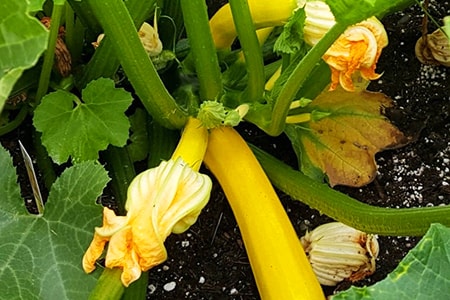
Wait until the spring when the last frost has passed before planting your seeds or transplants. The soil needs to reach at least 65 degrees Fahrenheit if not 70 degrees. Germination occurs best around an air temperature of 95 degrees.
Soil temperature is another factor that can affect plants. Take care to plant squash after the last frost has melted and the soil has warmed up. Frosty soil will freeze the plant cells and slow down growth, ultimately killing the plant.
Where to Plant Squash
One thing that you cannot compromise on when it comes to squash is space. It either grows into a large bushy plant or with long vines. So they require a lot of room to spread out.
You also need to provide adequate space between the plants. Overcrowding can restrict airflow and attract insects and pests. Knowing how to grow squash is knowing how much space they need.
They're usually planted on hills where they don't waste yard space or are well spaced out in an open garden. The bush variety should be planted in rows that are 4 to 6 feet apart and the plants should be placed 15 to 20 inches apart.
The vine varieties are planted in rows that are 6 to 12 feet apart, and the plants are spaced 12 to 15 inches apart. If you don’t have a lot of space to let the vines spread out you can spread them up a trellis.
How Long Does it Take Squash to Grow?
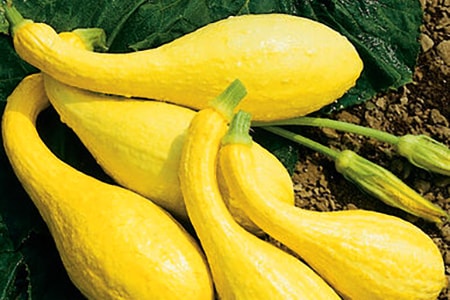
Most types of squash take 45 to 60 days between planting and harvesting. The seeds will germinate and sprout within 3 to 10 days depending on soil temperature and moisture conditions. Expect another 30 to 35 days before the plants begin flowering. Within 10 to 15 days, you'll begin to see the vegetables growing on the vines.
Caring for Squash Plants - Watering
Plants absorb nutrients from the soil through the water that you provide them. Every plant has different water requirements, but squash needs quite a bit more than others you may be used to.
A shortage of water will slow down the growth of plants as it’s not able to get all the nutrients it requires. At the same time, overwatering will cause the roots to rot.
Following a regular watering schedule and keeping an eye on your plant for telltale signs of over or underwatering will help you meet its water requirements.
Just make sure the soil is draining well, too. Especially make sure there's no standing water on the surface as this is a big sign the same thing is happening underground.
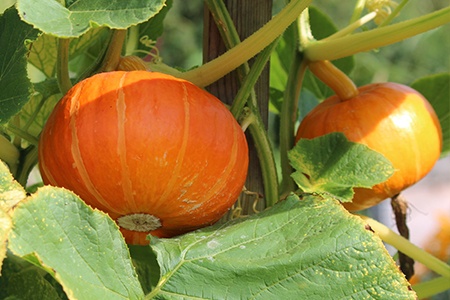
Squash requires sufficiently moist soil conditions. Ideally, they require one inch of water per week. This typically means that you should water the both the seeds and sproutlings and the mature plants once a week.
However, you might need to water more frequently if the soil is sandy or the weather is scorching without any natural rain. Proper water amounts are a key to how to grow squash.
One way to ensure that you give your plants enough water without ending up overwatering them is to set up a drip irrigation system or other underground sprinkler system alternatives.
If you don’t want to invest a lot of money for that you can always bury a perforated tin can next to your plant, with the top open and uncovered. Fill it up and let the water seep deep into the soil and get to all the roots.
Caring for Squash Plants - Sunlight
Squash grows best in full sunlight. The vines prefer warm weather, they give better fruit and higher yield if they get their daily dose of sunshine. On average, they require six hours of sunlight per day.
70 degrees Fahrenheit and above is the ideal temperature for growing healthy, large, and high-yielding squash. However, if it gets too hot or you are going through a heatwave, the plants will wilt and the flowers will fall off.
To prevent the plant from dying off in the heat you can use mulch liberally, put up a shade cloth, and water plants early in the morning.
When to Harvest Squash
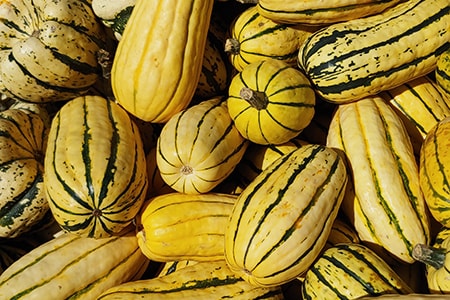
These crops grow quickly in warm weather. You can harvest frequently to get more yield as this can route energy to younger vegetables and give them a growth spurt.
The harvest readiness of your plants differs greatly based on whether you chose a summer or winter variety. The summer types starts producing fruit earlier and they produce more fruit than the winter varieties.
Summer squash must be harvested when the rinds are still soft. They're usually ready to be harvested around 60 days after planting. They must be harvested when they are still immature before the skin hardens. You should be able to easily pierce the rind with your fingernail.
If you let the fruits stay on the plant for too long, summer varieties will become hard, seedy, and less flavorful. Get them early and they'll continue to mature off the vine some until you use them.
Winter squash is picked only after the fruits are fully mature. You know they're harvest ready when the skin is thick and hard to pierce with a fingernail. These fruits don't ripen after harvest, so be careful to harvest only when fully mature to avoid wasting fruit.
Take care to leave at least one inch of stem on your winter squash when you harvest them. A broken stem causes rot and mold. These fruits do not taste good when eaten raw, they are usually used in baked, steamed or boiled dishes.
How to Store Squash
Summer squash can be stored up to two weeks in cool and moist areas. They can be eaten raw and are generally used in salads, stir fries or steamed dishes.
Winter types need to be cured by being left in the sun until the stem dries and browns before you can store them. They can be stored in a cool, dry location for up to 6 months.
Pests & Diseases That Affect Squash
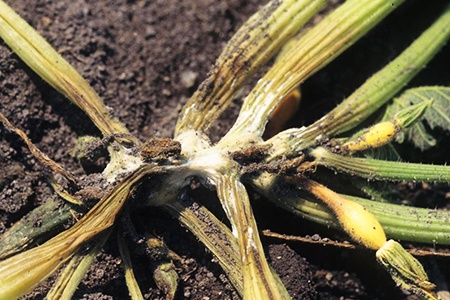
Squash plants are prone to a lot of diseases if you don't give them the right attention. These pests and diseases are even more common in hot and humid weather.
Powdery mildew and bacterial wilt are the most common diseases that these plants suffer from. Organic fungicides like neem oil solutions usually help keep these diseases at bay, as well as some pests like spider mites. Don't be left wondering where spider mites come from.
Bugs and vine borers are the most common pests found on these plants. Squash bugs are somewhat large, winged, brown bugs that cause spotting, wilting, and browning of leaves.
Squash vine borers are types of worms that insert themselves inside the stems of the plant. They cause the fruits to fall off and leaves to wilt.
While the bugs are easier to spot before they cause significant damage, vine borer infestations can be seen only after significant damage has already been done.
The only way to avoid pests is to check your plants daily for bugs and diseases. It doesn't take long to do and is worth it. Squash bugs can be gotten rid off by killing the adult bugs and destroying the eggs if discovered in the initial stages.
The best time to check for vine borers is at night. Shine any types of flashlights on the stems, the light will shine through healthy stems but will be blocked at the point of infestation.
You can gently slice the stem open, remove the worm and kill it off. However, big infestations usually kill off your plant even if you remove the worms.
That's How to Grow Squash!
If you plant both varieties in your vegetable patch, you will be able to enjoy different kinds of squash dishes all year round. Some can be eaten raw, while others make great pies and casseroles.
You can never go wrong with these versatile vegetables now that you know how to grow squash.



